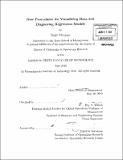| dc.contributor.advisor | Roy E. Welsch. | en_US |
| dc.contributor.author | Menjoge, Rajiv (Rajiv Shailendra) | en_US |
| dc.contributor.other | Massachusetts Institute of Technology. Operations Research Center. | en_US |
| dc.date.accessioned | 2011-02-23T14:26:53Z | |
| dc.date.available | 2011-02-23T14:26:53Z | |
| dc.date.copyright | 2010 | en_US |
| dc.date.issued | 2010 | en_US |
| dc.identifier.uri | http://hdl.handle.net/1721.1/61190 | |
| dc.description | Thesis (Ph. D.)--Massachusetts Institute of Technology, Sloan School of Management, Operations Research Center, 2010. | en_US |
| dc.description | Cataloged from PDF version of thesis. | en_US |
| dc.description | Includes bibliographical references (p. 97-103). | en_US |
| dc.description.abstract | This thesis presents new methods for exploring data using visualization techniques. The first part of the thesis develops a procedure for visualizing the sampling variability of a plot. The motivation behind this development is that reporting a single plot of a sample of data without a description of its sampling variability can be uninformative and misleading in the same way that reporting a sample mean without a confidence interval can be. Next, the thesis develops a method for simplifying large scatter plot matrices, using similar techniques as the above procedure. The second part of the thesis introduces a new diagnostic method for regression called backward selection search. Backward selection search identifies a relevant feature set and a set of influential observations with good accuracy, given the difficulty of the problem, and additionally provides a description, in the form of a set of plots, of how the regression inferences would be affected with other model choices, which are close to optimal. This description is useful, because an observation, that one analyst identifies as an outlier, could be identified as the most important observation in the data set by another analyst. The key idea behind backward selection search has implications for methodology improvements beyond the realm of visualization. This is described following the presentation of backward selection search. Real and simulated examples, provided throughout the thesis, demonstrate that the methods developed in the first part of the thesis will improve the effectiveness and validity of data visualization, while the methods developed in the second half of the thesis will improve analysts' abilities to select robust models. | en_US |
| dc.description.statementofresponsibility | by Rajiv Menjoge. | en_US |
| dc.format.extent | 103 p. | en_US |
| dc.language.iso | eng | en_US |
| dc.publisher | Massachusetts Institute of Technology | en_US |
| dc.rights | M.I.T. theses are protected by
copyright. They may be viewed from this source for any purpose, but
reproduction or distribution in any format is prohibited without written
permission. See provided URL for inquiries about permission. | en_US |
| dc.rights.uri | http://dspace.mit.edu/handle/1721.1/7582 | en_US |
| dc.subject | Operations Research Center. | en_US |
| dc.title | New procedures for visualizing data and diagnosing regression models | en_US |
| dc.type | Thesis | en_US |
| dc.description.degree | Ph.D. | en_US |
| dc.contributor.department | Massachusetts Institute of Technology. Operations Research Center | |
| dc.contributor.department | Sloan School of Management | |
| dc.identifier.oclc | 701065736 | en_US |
